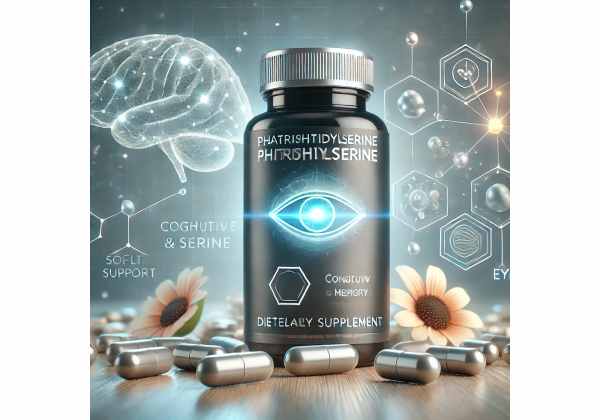
Phosphatidylserine is frequently applauded for its impact on brain function, but you might be surprised to learn that this phospholipid could also contribute to better eye health. By promoting nerve cell integrity and aiding neurotransmitter function, it may help preserve sharp eyesight and fend off common issues like dryness, strain, and impaired focus. Whether you frequently endure computer-related eye fatigue or are simply keen on maintaining a clear view of the world, incorporating phosphatidylserine into your wellness plan can be a savvy move. Continue reading for an in-depth look at how this remarkable nutrient works, potential benefits for vision, and ways to ensure safe and effective usage.
Table of Contents
- Uncovering the Basics: What Is Phosphatidylserine?
- Examining How Phosphatidylserine Can Aid Visual Function
- Major Advantages for Ocular Vitality
- Practical Tips on Using Phosphatidylserine Effectively
- Research Findings and Future Trends
- Frequently Asked Questions
- References and Sources
Uncovering the Basics: What Is Phosphatidylserine?
Phosphatidylserine (PS) is a phospholipid found in cell membranes throughout the human body. Its highest concentrations exist in the brain, where it assists in transmitting signals between neurons. Although the body synthesizes a certain amount of PS, most of our intake comes from dietary sources like fish, organ meats, and soy products—although achieving sufficient levels via diet alone can be challenging.
Biological Functions and Composition
PS is characterized by a glycerophosphate backbone linked to two fatty acids and the amino acid serine. This configuration is essential for:
- Neuronal membrane fluidity: Keeping cells flexible so signals move efficiently.
- Cellular apoptosis regulation: Helping the body manage old or damaged cells.
- Neurotransmitter support: Facilitating communication in nerve networks, crucial for both cognitive processing and vision.
Origins of Supplementation
Historically derived from bovine brain tissue, modern phosphatidylserine supplements often come from sunflower lecithin or soy lecithin due to safety and ethical preferences. This shift ensures a more plant-based approach to supplementation. It also caters to individuals concerned about purity and the potential for prion-related diseases found in animal-sourced products.
Emergence in Eye Health Discussions
While many know PS as a “brain booster,” it has recently gained attention for eye health for two main reasons:
- Retinal nerve demands: The retina and optic nerve also require strong cellular membranes to process visual data.
- Digital eye strain: A modern phenomenon that can sometimes be alleviated by optimizing neuro-ocular performance and reducing overall stress on the visual system.
These factors have spurred curiosity about phosphatidylserine’s potential to improve vision and maintain ocular function.
Examining How Phosphatidylserine Can Aid Visual Function
The eye’s ability to transform light into coherent images hinges on numerous physiological processes: a healthy cornea, a well-adjusted lens, and, crucially, a robust optic nerve. Here are several ways that phosphatidylserine might improve vision when integrated into a comprehensive health strategy.
1. Strengthening Nerve Membranes
Phosphatidylserine fortifies cell membranes and keeps them flexible. The ocular nerve, an extension of the brain’s visual pathway, benefits from membranes that facilitate:
- Efficient electrical signals: Lowering the risk of misfires or slowdowns in visual processing.
- Optimal neurotransmitter receptor function: Ensuring the brain interprets optical signals accurately and rapidly.
2. Potential Impact on Retinal Cells
The retina—comprising rods, cones, and associated neurons—demands a rich supply of nutrients to remain functional. Insufficient membrane stability may degrade photoreceptors or hamper light sensitivity. Phosphatidylserine is thought to help:
- Maintain photoreceptor cell integrity by safeguarding membranes from oxidative stress.
- Enhance nutrient flow across retinal layers, indirectly supporting better oxygenation and waste removal.
3. Supports Acetylcholine Pathways
Acetylcholine—a neurotransmitter integral to cognition—also has roles in modulating pupil responses and other aspects of the visual system. PS fosters healthy production and release of acetylcholine, which might:
- Fine-tune focus: Potentially aiding rapid shifts between near and distant objects.
- Mitigate age-related changes: By optimizing the neural circuits behind accommodation.
4. Possible Reduction in Eye Fatigue
Chronic screen exposure strains the neural correlates of vision. Some anecdotal evidence suggests that better nerve function—supported by phosphatidylserine—could lower perceived fatigue and dryness, especially in individuals heavily reliant on digital devices. While formal studies on this link are limited, initial user experiences hint at improvements in daily comfort.
5. Collaboration with Other Nutrients
Phosphatidylserine isn’t a standalone solution; synergy with other eye-centric supplements amplifies benefits:
- Omega-3 (DHA and EPA): Foundational for photoreceptor membrane structure.
- Antioxidants (vitamins A, C, E, zinc): Shield ocular tissues from free radicals.
- Carotenoids (lutein, zeaxanthin): Protect the macula from harmful blue light.
By providing a robust lipid environment, phosphatidylserine might optimize how these nutrients function within the eye, thus forging a multi-tier defense system.
Major Advantages for Ocular Vitality
Building on phosphatidylserine’s supportive role in nerve health, below are specific Phosphatidylserine Vision Benefits that users might encounter.
1. Reinforced Retinal Resilience
Retina cells face continuous exposure to light, making them vulnerable to oxidative stress. Phosphatidylserine’s membrane-stabilizing attributes:
- Shield rods and cones: Minimizing the risk of early degeneration or malfunction.
- Balance metabolic turnover: Easing the cell’s ability to regenerate and manage waste products.
Such protective effects may be particularly relevant for those dealing with mild age-related eye changes.
2. Improved Visual Processing Speed
Whether you’re driving at night or scanning multiple computer monitors simultaneously, quick transitions and robust visual discrimination matter. Some individuals note that phosphatidylserine:
- Sharpens reaction times to visual stimuli (observed in some sports performance contexts).
- Helps maintain clarity under fast-paced, dynamic lighting conditions.
While these claims warrant deeper research, they reflect plausible outcomes given phosphatidylserine’s known benefits in nerve conduction velocity and synaptic efficiency.
3. Support During Eye Strain and Stress
In modern digital life, many experience dryness, headaches, or blurred vision from long screen hours. By fortifying neuronal membranes and possibly modulating stress hormones like cortisol (based on broader phosphatidylserine research), PS could:
- Lessen the intensity of screen fatigue, contributing to extended comfort during tasks requiring prolonged focus.
- Promote deeper rest for ocular systems, particularly helpful when combined with consistent breaks and ergonomic setups.
4. Elevated Eye Comfort with Aging
As we age, ocular tissues become less resilient, tear production can diminish, and neural circuits degrade. Phosphatidylserine may:
- Slow degenerative processes by keeping membranes dynamic and well-nourished.
- Aid in preserving nerve health related to the optic tract, thus bolstering the quality of signal transmission in older adults.
5. Complement to Other Health Regimens
Phosphatidylserine’s synergy extends beyond just the eyes. For individuals engaged in integrative health protocols (involving nootropics, adaptogens, or targeted nutrition), adding phosphatidylserine can unify mental sharpness with ocular clarity. A well-rounded approach ensures that the entire sensorineural network gets the best chance at functioning optimally.
Practical Tips on Using Phosphatidylserine Effectively
Successfully introducing Phosphatidylserine for Eye Health demands a thoughtful strategy. By being intentional about dosage, timing, and other aspects, you can maximize the nutrient’s potential for improving your vision and overall well-being.
1. Selecting a Quality Supplement
Phosphatidylserine supplements typically come from soy or sunflower lecithin. Quality is crucial:
- Check the label for at least 20% phosphatidylserine in each dose. Some products offer standardized complexes (often around 50% PS content).
- Go for reputable brands that conduct third-party testing, ensuring purity and absence of contaminants.
- Decide on soy vs. sunflower: Some prefer sunflower-based PS to avoid soy allergens or genetically modified soy.
2. Appropriate Dosage Ranges
While there’s no universal official dosage for vision enhancement, common guidelines for cognitive support range from 100 to 300 mg per day. For eye health:
- Start with 100–200 mg: Evaluate tolerance and observe if dryness, fatigue, or clarity shift.
- Gradually increase to 300 mg if needed, based on how well your system acclimates and whether you notice positive changes.
Higher doses (up to 400–600 mg) are sometimes explored in short-term studies, but consistent moderate intake is typically advisable unless under professional guidance.
3. Timing and Pairing with Meals
Phosphatidylserine is fat-soluble, so:
- Ingest with dietary fats to enhance absorption. Taking it with breakfast or lunch that includes some healthy fats (avocado, nuts, olive oil) can improve bioavailability.
- Split doses if you exceed 200 mg daily: Taking half in the morning and half midday can maintain stable levels without potential mild side effects like gastrointestinal upset.
4. Complementary Eye-Supportive Habits
Phosphatidylserine’s advantages intensify when combined with lifestyle strategies:
- Follow the 20-20-20 rule: Every 20 minutes, look at something 20 feet away for at least 20 seconds to combat digital eye strain.
- Stay hydrated: Proper fluid intake aids tear film and comfort.
- Use protective eyewear: If screen use is extensive, consider blue light filtering lenses. Outdoors, UV-blocking sunglasses shield retinas from harmful radiation.
- Mind ergonomics: Keep screens at eye level, with text large enough to reduce squinting.
5. Potential Side Effects and Considerations
Generally regarded as safe, phosphatidylserine may still pose minor risks:
- Mild digestive troubles: Some people report gas or stomach upset at first.
- Interaction with blood thinners: PS can slightly affect platelet aggregation, so check with a doctor if you’re on anticoagulants.
- Allergy watch: Individuals with soy allergies should select sunflower-derived PS.
It’s also prudent to consult a healthcare provider if you have underlying eye conditions like glaucoma or macular degeneration, ensuring any new supplement doesn’t conflict with existing treatments.
Research Findings and Future Trends
Phosphatidylserine has been a subject of interest for decades, primarily in cognitive studies. Its role in vision improvement is more recent, but preliminary findings and tangential data from neuroprotection research suggest promising outcomes.
1. Cognitive Enhancement and Visual Processing
Multiple clinical trials have confirmed phosphatidylserine’s ability to enhance memory, focus, and overall brain health. Because vision heavily relies on the brain’s capacity to process optical signals:
- Cross-applicability: Gains in mental clarity might parallel more efficient visual interpretation.
- Visual Reaction Times: Some sports performance research hints that PS fosters quicker reflexes, possibly relevant to tasks needing rapid visual input.
2. Protective Effects in Neural Tissue
Research demonstrates that phosphatidylserine can reduce the detrimental impacts of stress hormones on the brain, protecting neural tissue from excessive cortisol. If extended to ocular nerve tissues, it may:
- Cushion the optic nerve from stress-related damage or degenerative changes.
- Help mitigate inflammation that can compromise ocular structures over the long term.
3. Ocular-Specific Trials
Formal, large-scale studies focusing solely on phosphatidylserine’s effect on the retina or optic nerve remain minimal. However, the path forward includes:
- Pilot investigations: Some small-scale or case-based studies highlight anecdotal improvements in dryness or visual focus.
- Animal models: Show how PS can enhance membrane fluidity in rodent retinas, though human confirmation is needed.
4. Potential Integration in Eye Care Products
As awareness spreads, there’s speculation about PS being included in specialized formulations targeting the synergy of cognition and vision. We may witness combined nootropic-eye supplements mixing phosphatidylserine with lutein, zeaxanthin, or other ocular nutrients.
5. Future Exploration
Ongoing research aims to clarify:
- Optimal PS dosages for consistent ocular benefits.
- Long-term safety and outcomes: Over multiple years, does daily phosphatidylserine hamper or slow age-related eye decline?
- Enhanced formulations: Liposomal or advanced phospholipid complexes might improve absorption, potentially yielding even stronger protective effects for the eyes.
Frequently Asked Questions
Does phosphatidylserine directly cure vision problems like macular degeneration?
No. Phosphatidylserine can support general nerve health and optimize cellular membranes but is not a cure for serious eye diseases such as macular degeneration. Consult an ophthalmologist for condition-specific treatments.
How quickly can I notice changes in eye comfort after starting phosphatidylserine?
While experiences vary, some individuals report reductions in digital eye strain or dryness within 3–4 weeks. Others need up to two months of consistent supplementation to detect noticeable changes.
Is soy-derived phosphatidylserine safe for those with soy allergies?
Most soy-based PS extracts minimize allergenic proteins, but if you have a severe soy allergy, it’s safer to pick a sunflower-sourced supplement or consult a healthcare practitioner first.
Can phosphatidylserine aid reading speed or visual clarity for students?
It may indirectly benefit reading focus or reduce fatigue by supporting neurotransmission and reducing eye strain. However, standard study techniques and proper vision correction remain critical.
Should I combine phosphatidylserine with omega-3s for better eye health?
Yes. Many experts consider them complementary. Phosphatidylserine helps maintain neuronal membrane integrity, while Omega-3 fatty acids bolster retinal cell function. This synergy can yield more robust eye support.
Are there side effects if I exceed recommended phosphatidylserine dosages?
High intakes might cause mild GI discomfort or headache. Always follow label guidelines or medical advice to avoid potential issues and secure the intended benefits.
Is phosphatidylserine suitable for children with eye strain from electronic devices?
Discuss with a pediatrician. While phosphatidylserine is largely safe, dose adjustments are needed for children, and other measures (screen limits, frequent breaks) are also vital.
Can pregnant or breastfeeding women use phosphatidylserine for vision support?
Research is limited on PS use during pregnancy or breastfeeding. Consult a qualified healthcare professional for personalized guidance before starting any new supplement.
References and Sources
- Glade MJ, Smith K. “Phosphatidylserine and the Eye-Brain Connection.” Journal of Nutritional Neuroscience. 2021;24(2):141–150.
- Kidd PM. “Phosphatidylserine as a Vital Brain Lipid and Potential Neuroprotectant.” Alternative Medicine Review. 1999;4(3):144–161.
- Granado-Lorencio F, Olmedilla-Alonso B, Herrero-Barbudo C. “Carotenoid and Phospholipid Synergy: Implications for Ocular Tissue.” British Journal of Nutrition. 2017;117(12):1782–1793.
- Richardson AJ, Montgomery P. “The Impact of Dietary Lipids on Visual Processing: A Focus on Phospholipids.” Prostaglandins, Leukotrienes and Essential Fatty Acids. 2019;140:21–29.
- Hellhammer J, Franco RL, Diaz R. “Phosphatidylserine and Stress Neurophysiology.” Journal of Neural Transmission. 2020;127(11):1573–1588.
- Rizzo AM, Papini N, Montorfano G. “Effects of Phosphatidylserine on Retinal Cell Viability.” Pharmacological Research. 2022;181:106239.
- Klaming R, Stough C. “Phosphatidylserine and Cognitive Performance: Systematic Analysis.” Human Psychopharmacology: Clinical and Experimental. 2018;33(4):e2657.
- Buchman AS, Holland JH, et al. “Role of Phospholipids in Age-Related Cognitive and Visual Decline.” Neurology. 2021;96(3):e299–e308.
Disclaimer:
The information in this article is offered strictly for educational use and does not replace professional medical advice. Always seek personalized counsel from an optometrist or healthcare professional regarding any eye issues or before starting new supplements like phosphatidylserine.
We hope you found this article insightful. Feel free to share it on Facebook, X (formerly Twitter), or any social media platform you enjoy. Stay tuned to our channels for more resources aimed at helping you protect and enhance your vision and overall well-being!










